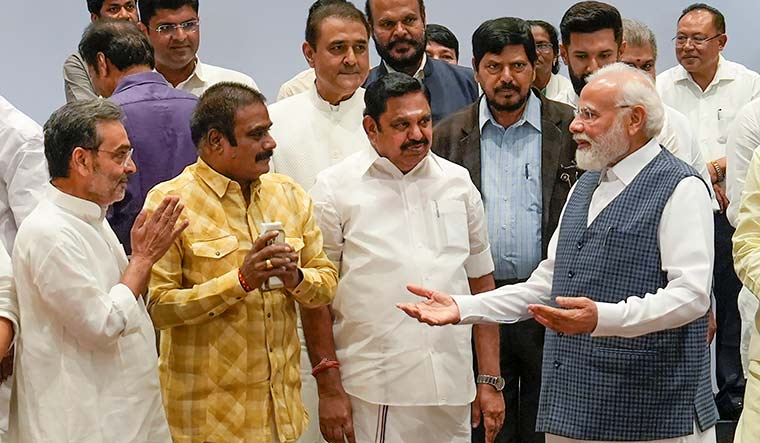POLITICS IS A GAME of perception, and a clever turn of phrase can make or mar an election. During the 2014 and 2019 Lok Sabha elections, the BJP used the chaiwala and chowkidar jibes against Narendra Modi to establish a connect with voters. For 2024, following the decision of the opposition parties to use the acronym INDIA to define their united front, Modi has come up with his own expansion for the NDA―New India, Development, Aspiration.
Could the 2024 elections be a war between INDIA and New India, the jury is still out, but copywriters on both sides will be working overtime to come up with cleverer versions and slogans. But on the battleground, both sides have revealed their formations. As against INDIA’s 26 parties, the BJP-led alliance showcased 38 constituents, reviving the idea of the National Democratic Alliance, which is in its 25th year of existence. As the last two general elections have shown, the BJP has done well to secure a majority on its own. The major difference this time is the joint effort by the opposition parties to come together on a single platform, prompting the BJP to bring in smaller regional parties to bolster its chances in key states like Uttar Pradesh, Bihar and Maharashtra and also in the northeast.
Conspicuous by their absence during the NDA meeting were former allies like the Telugu Desam Party and the Akali Dal. The Janata Dal (Secular), which has indicated that it might go with the NDA, also stayed away. These former allies are up against formidable challenges on their home grounds and could do well if they were to join the NDA. The BJP, however, senses an opportunity to expand its base in Andhra Pradesh and Punjab―an opportunity the party never had when the TDP and the Akali Dal were part of the NDA. In Karnataka, bringing the JD(S) in may help the Congress more, ironically. During the recent assembly elections, the JD(S) votes got transferred to the Congress as there was a perception that it was closer to the saffron party.
For the BJP, the alliances are also strategic. There are non-aligned parties like the YSR Congress in Andhra Pradesh, the Biju Janata Dal in Odisha and the Bahujan Samaj Party in Uttar Pradesh, which are expected to halt the growth of the Congress-led alliance in their respective states. Moreover, these parties have sided openly or indirectly with the government in Parliament. The BSP with its captive dalit votes can eat into the Congress vote share in the upcoming assembly polls in Madhya Pradesh, Chhattisgarh and Rajasthan.
BJP president J.P. Nadda said ideology was constant for his party. Only allies who abide by the ideology can come in, but the party’s political strategy is “dynamic”, changing with the situation on the ground. A closer look at its allies reveals regional parties like those led by Upendra Kushwaha, O.P. Rajbhar, Chirag Paswan and Jitan Ram Manjhi, with their own caste-based voters. The BJP hopes that they will come in handy in countering the joint opposition and its demands like the caste-based census. The party is aware that the demand could lead to a relaunch of the ‘Mandal versus kamandal’ debate, hurting its aggressive hindutva agenda.
Modi’s televised speech during the NDA meeting set the tone for the BJP’s campaign. “It is a beautiful rainbow of regional aspirations,” said Modi, describing the NDA’s composition. It was a hint that the BJP celebrates diversity and honours local interests. It was also a slight deviation from the party’s earlier stance where it stressed on a bipolar polity, sidelining regional, caste-based and family parties.
Modi blamed the opposition for corruption and “opportunistic” alliances. The party hopes to highlight the contradictions among the opposition parties as many of them are opposed to each other during state-level elections. For instance, the Congress and the Aam Aadmi Party are bitter rivals in Delhi and Punjab, while in West Bengal, the Trinamool Congress is challenged by the left and the Congress. The BJP’s strategy would be to invoke the enmity between their cadres so that the transfer of votes is not easy. The alliance between the BSP and the Samajwadi Party appeared formidable on paper during the 2019 Lok Sabha elections, but the failure in transferring the votes resulted in the BJP winning comfortably.
The BJP’s door remains open for former allies like the TDP and the Akali Dal and the final decision will be made depending on the evolving political situation. The draft of the Uniform Civil Code will have a bearing on how the Akali Dal will position itself. The party is unlikely to forget the setback it faced when it was part of the NDA government which passed the farm laws.
A bigger test for the BJP will come while sharing seats with its new allies. In Maharashtra, the Ajit Pawar faction of the NCP and the Eknath Shinde faction of the Shiv Sena will demand a decent share of seats. Haryana will pose another major headache even as the Jannayak Janata Party of Deputy Chief Minister Dushyant Chautala attended the NDA meet. The BJP had won all 10 Lok Sabha seats last time and the local unit of the party is against seat sharing. However, to let the alliance continue, there will be pressure on the central leadership to give the JJP a few seats.
The BJP is confident that the beneficiaries of the Central welfare schemes, especially dalits, women, tribals and the youth, will support the party. “History and chemistry is being seen by everyone, now arithmetic will be on our side,” said Modi. “The NDA had 37 per cent vote share in 2014, which rose to 45 per cent in 2019, and now in 2024, we are sure that people will give us over 50 per cent.”


